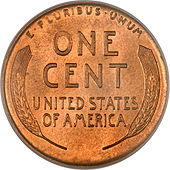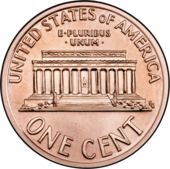Penny (United States coin)
| United States | |
| Value | 0.01 U.S. Dollars |
|---|---|
| Mass | 2.5 g (0.080 troy oz) |
| Diameter | 19.05 mm (0.750 in) |
| Thickness | 1.52 mm (0.0598 in) |
| Edge | Plain |
| Composition | 1982–present copper-plated zinc 97.5% Zn, 2.5% Cu |
| Years of minting | 1793–present |
| Catalog number | – |
| Obverse | |
 |
|
| Design | Abraham Lincoln |
| Designer | Victor D. Brenner |
| Design date | 1909 (design was modified in 2010) |
| Reverse | |
 |
|
| Design | Union Shield |
| Designer | Lyndall Bass |
| Design date | 2010–present |
| Reverses of the Lincoln cent |
|---|
The United States one-cent coin often called penny, is a unit of currency equaling one-hundredth of a United States dollar. The cent's symbol is ¢. Its obverse has featured the profile of President Abraham Lincoln since 1909, the centennial of his birth. From 1959 (the sesquicentennial of Lincoln's birth) to 2008, the reverse featured the Lincoln Memorial. Four different reverse designs in 2009 honored Lincoln's 200th birthday and a new, "permanent" reverse – the Union Shield – was introduced in 2010. The coin is 0.75 inches (19.05 mm) in diameter and 0.0598 inches (1.52 mm) in thickness. Its weight has varied, depending upon the composition of metals used in its production (see further below).
The U.S. Mint's official name for the coin is "" and the U.S. Treasury's official name is "one cent piece". The colloquial term penny derives from the British coin of the same name, the pre-decimal version of which had a similar place in the British system. In American English, pennies is the plural form. (The plural form pence—standard in British English—is not used in American English.)
Although the coin's abolition has been proposed because it is now worth very little, there are currently no firm plans to eliminate the penny. As of 2015, based on the U.S. Mint Annual Report released for 2014, it costs the U.S. Mint 1.67 cents (down from 2.41 cents in 2011 and 1.83 cents in 2013) to make one cent because of the cost of materials, production, and distribution. This figure includes the Mint's fixed components for distribution and fabrication, as well as Mint overhead allocated to the penny. Fixed costs and overhead would have to be absorbed by other circulating coins without the penny. The loss from producing the one cent coin in the United States for the year of 2013 was $55,000,000. This was a slight decrease from 2012, the year before, which had a production loss of $58,000,000.
...
Wikipedia







